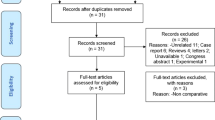Abstract
A section of the filum terminale (SFT) is used for the surgical treatment of isolated tethered cord or that resulting from neurulation disorders. More recently, it has been proposed for the management of the occult tethered cord syndrome (OTCS), though it is still under debate. Even more controversial appears to be the use of SFT in patients with Chiari type I malformation (CIM), which is based on the possible presence of OTCS. This review shows that: (1) there are issues both in favor and against the occurrence of OTCS, (2) there is no significant correlation between CIM and tethered cord, the old “caudal traction theory” being not supported by clinical or experimental evidences. On these grounds, a relationship between CIM and OTCS is hard to be demonstrated, (3) a subgroup of patients with CIM suffering from OTCS may exist and benefit from SFT.
Similar content being viewed by others
References
Milhorat TH, Bolognese PA, Nishikawa M, Francomano CA, McDobbell NB, Roonprapunt C, Kula RW (2009) Association of Chiari malformation type I and tethered cord syndrome: preliminary results of sectioning filum terminale. Surg Neurol 72:20–35
Abel TJ, Chowdhary A, Gabikian P, Ellenbogen RD, Avellino AM (2006) Acquired Chiari malformation type I associated with a fatty terminal filum: case report. J Neurosurg 105:329–332
Selçuki M, Vatansever S, Inan S, Erdemli E, Bagdatoglu C, Polat A (2003) Is a filum terminale with a normal appearance really normal? Childs Nerv Syst 19:3–10
Selden NR, Nixon RR, Skoog SR, Lashley DB (2006) Minimal tethered cord syndrome associated with thickening of the terminal filum. J Neurosurg 105:214–218
Tubbs RS, Oakes WJ (2004) Can the conus medullaris in normal position be tethered? Neurol Res 26:727–731
Wehby MC, O’Hollaren PS, Abtin K, Hume JL, Richards BJ (2004) Occult tight filum terminale syndrome: results of surgical untethering. Pediatr Neurosurg 40:51–58
Drake JM (2006) Occult tethered cord syndrome: not an indication for surgery. J Neurosurg 104:305–308
Selden NR (2007) Minimal tethered cord syndrome: what’s necessary to justify a new surgical indication? Neurosurg Focus 23:E1
Sureshkumar P, Craig JC, Roy LP, Knight JF (2000) Daytime urinary incontinence in primary school children: a population-based survey. J Pediatr 137:814–818
Royo-Salvador MB, Solé-Llenas J, Doménech JM, González-Adrio R (2005) Results of the section of the filum terminale in 20 patients with syringomyelia, scoliosis and Chiari malformation. Acta Neurochir 147:515–523
Gluncic V, Turner M, Burrowes D, Frim D (2011) Concurrent Chiari decompression and spinal cord untethering in children: feasibility in a small case series. Acta Neurochir (Wien). 153(1):109–114
Tubbs RS, Bui CJ, Rice WC, Loukas M, Naftel RP, Holcombe MP, Oakes WJ (2007) Critical analysis of the Chiari malformation type I found in children with lipomyelomeningocele. J Neurosurg 106:196–200
Tubbs RS, Loukas M, Shoja MM, Oakes WJ (2007) Observations at the craniocervical junction with simultaneous caudal traction of the spinal cord. Childs Nerv Syst 23:367–369
Steinbok P, Kariyattil R, MacNeily AE (2007) Comparison of section of filum terminale and non-neurosurgical management for urinary incontinence in patients with normal conus position and possible occult tethered cord syndrome. Neurosurgery 61:550–556
Bauer DF, Tubbs RS, Chambers MR (2009) Study of the effects of flexion on the position of the conus medullaris: follow-up study using MR imaging in non-human primates. Childs Nerv Syst 25:977–979
Conflict of interest
The authors declare that there is no actual or potential conflict of interest in relation to this article.
Author information
Authors and Affiliations
Corresponding author
Rights and permissions
About this article
Cite this article
Massimi, L., Peraio, S., Peppucci, E. et al. Section of the filum terminale: is it worthwhile in Chiari type I malformation?. Neurol Sci 32 (Suppl 3), 349–351 (2011). https://doi.org/10.1007/s10072-011-0691-4
Published:
Issue Date:
DOI: https://doi.org/10.1007/s10072-011-0691-4




